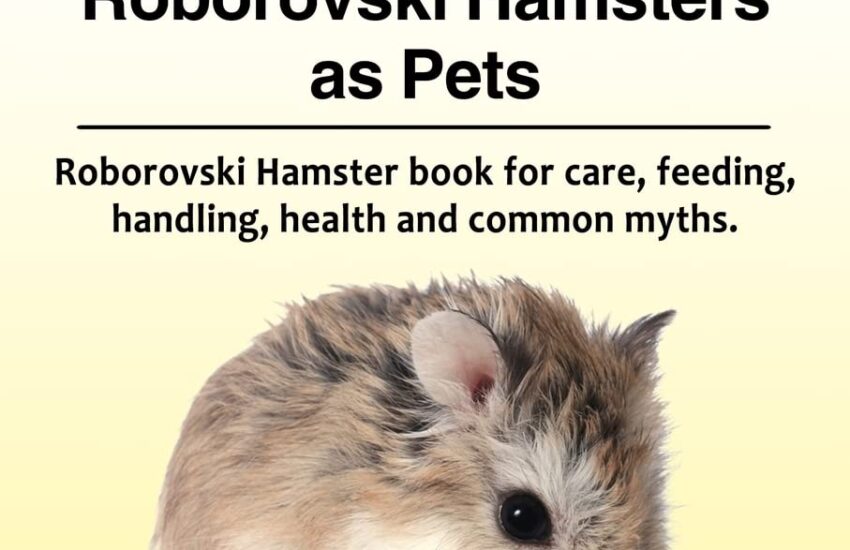Common Myths About Hamster Types
Understanding Hamster Varieties
Hamsters make popular pets thanks to their adorable appearance and playful nature. However, some misinformation exists about the different types of hamsters. Understanding hamster varieties is crucial for prospective pet owners. In this section, we will clarify common misconceptions linked to **Syrian**, **Dwarf**, and **Roborovski** hamsters. Each type possesses distinct characteristics, which makes it vital to separate fact from fiction when considering them as pets.

Myth 1: All Hamsters Are the Same
A common misconception is that all **hamster** types share the same behavior and care requirements. This myth can lead to frustration for new hamster owners. Syrian hamsters, for instance, are much larger and generally more solitary than their dwarf counterparts. On the other hand, **Dwarf hamsters** such as the Campbell’s and Winter White can easily live in pairs or small groups. Understand these distinctions to better cater to your **pet hamster’s** needs.
Myth 2: Hamsters and Mice Are the Same
Another frequent myth is the assumption that hamsters are simply a larger version of mice. While both belong to the rodent family, hamsters and mice exhibit significant differences in behavior and care needs. For instance, hamsters are nocturnal, while many mice are crepuscular. Additionally, hamsters are more territorial, often preferring solitary living arrangements. Learning about these contrasts is essential for any prospective rodent owner.
Myths Surrounding Hamster Care
Proper care is crucial to ensuring a healthy, happy **hamster**. Unfortunately, several myths persist about hamster care, which can lead to mismanagement and poor health conditions. This section will debunk these myths, ensuring that you can provide the best environment for your **hamster** friend.
Myth 3: Hamsters Only Eat Seeds
This myth can lead owners to neglect providing a balanced and nutritious diet for their **hamster**. In reality, hamsters require a mix of commercial hamster pellets, fresh fruits, vegetables, and occasional treats. While seeds are a part of a hamster’s diet, relying solely on them can result in health problems. Providing variety is essential for your **hamster’s** wellness.
Myth 4: Hamsters Don’t Require Much Interaction
Some may believe that hamsters are low-maintenance pets that require little interaction. While they are relatively independent creatures, **hamsters** do need social interaction to thrive. Spending time handling, playing, and allowing **hamsters** to explore outside their cage promotes both bonding and exercise. Engaging with your **hamster** enhances their wellbeing.
The Importance of Proper Housing
Another essential aspect of a healthy hamster’s life is their environment. Understanding the myths about housing can greatly affect a **hamster’s** quality of life. Let’s look into some common misconceptions associated with hamster habitats.
Myth 5: Any Cage Will Do
Not all habitats are suitable for a hamster. Some assume that small cages provide sufficient space for a pet hamster. In reality, a larger cage allows for more room to explore and exercise. Furthermore, hamsters are known for being avid chewers; thus, having a robust, escape-proof cage is essential. A well-maintained cage environment enhances your **hamster’s** happiness and health.
Myth 6: Hamsters Can Live in Groups
Contrary to popular belief, not all **hamsters** can live harmoniously with others. Syrian hamsters, for instance, are solitary and can display aggressive behavior towards others. This myth can lead to potential injuries or stress for the hamsters involved. However, dwarf hamsters can sometimes live in pairs if introduced correctly from a young age. Understanding hamster social structures is vital to ensuring their wellbeing.
Insights into Hamster Behavior
Understanding the behavioral patterns of **hamsters** often dispels common misunderstandings about these cute critters. Pet owners must grasp these behaviors to foster a suitable living environment and nurture their hamsters appropriately.
Myth 7: Hamsters Are Dangerous Pets
Many believe that hamsters are aggressive or unpredictable pets. In truth, most hamsters are friendly if handled gently and raised in a nurturing environment. Working with your hamster from a young age can yield a well-socialized pet that enjoys being held and played with. Always approach with care, as sudden movements may startle them.
Myth 8: Hamsters Are Nocturnal and Don’t Play
While it is true that **hamsters** are primarily nocturnal, this does not mean they lack opportunities for play. **Hamster** toys, tunnels, and mazes can provide excellent stimulation, even during their wakeful hours. Investing in interactive toys encourages natural behaviors and keeps them mentally engaged. Make sure to offer ample opportunities for exercise, regardless of the time of day.
Key Takeaways
- Understanding different **hamster types** is vital for proper care.
- Myths about care, including diet and housing, can negatively affect your hamster’s health.
- Social interaction and playtime are necessary for a healthy hamster.
- Not all hamsters can live together; respect their territorial nature.
FAQ
1. How much space do hamsters require in their cages?
Hamsters generally need a minimum of 450 square inches of floor space for adequate movement. Providing a larger cage allows them to explore freely and reduces stress, which contributes to their overall health.
2. What type of bedding is best for hamsters?
Suitable bedding materials include aspen shavings, paper bedding, and coconut fiber. Avoid cedar and pine shavings, as they can be harmful to hamsters’ respiratory systems because of their strong scents and oils.
3. Can hamsters eat fruit?
Yes, hamsters can eat small amounts of fruits such as apples and bananas as part of a balanced diet. However, avoid sugary or acidic fruits and ensure moderation to prevent obesity or digestive issues.
4. How often should I clean my hamster’s cage?
You should clean your hamster’s cage at least once a week to maintain hygiene and to prevent the build-up of waste and odors. Spot cleaning as needed during the week is also advisable.
5. Is it normal for my hamster to burrow?
Burrowing is a natural behavior for hamsters, as it mimics their activities in the wild. Providing shredded paper or similar bedding mimics their natural habitat and allows them to engage in this instinctive behavior.
